James Rielly holds first exhibition in Wales in a decade
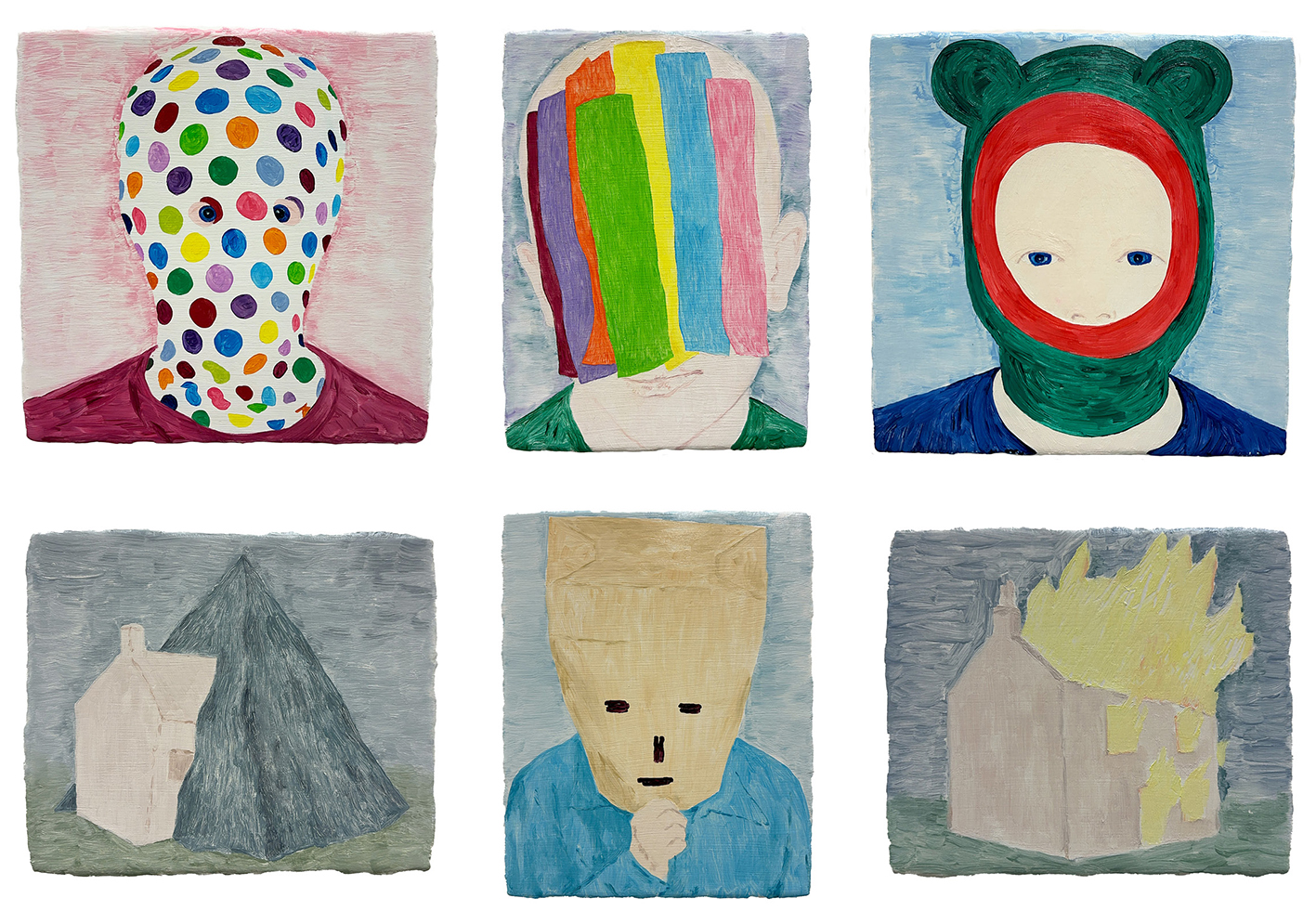
Michael Tooby Professor of Curatorial Practice, Bath Spa University
A solo exhibition of new work by celebrated artist James Rielly – his first in Wales in over a decade – is set to take place this month.
Rielly is one of the notable Young British Artists of the 1990s and his work is part of collections such as Tate, Saatchi and the National Museum of Wales. He grew up in Holyhead and now lives in France and exhibits internationally
Tŷ Hyll, which launches at Gallery Ten on 25 October includes a series of oil on canvas paintings, heavily gessoed and delicately painted. Akin to religious frescos, we see familiar and reoccurring motifs – some of these present throughout Rielly’s career – his own-made iconography offering modern-day parables.
These paintings appear as a snapshot of an ongoing narrative, a ‘still’ of a fantastically mysterious and inherently dark folk tale.
They tread the edge of the bizarre and the familiar with no obvious context, simultaneously threatening and cutesy, swaying between tragedy and comedy, and landing squarely in the wholly relevant.
Gallows humour
All are intimate in scale and draw in the viewer – at times the subject meets our gaze as we look, others hide completely behind a mask, playful yet unnerving.
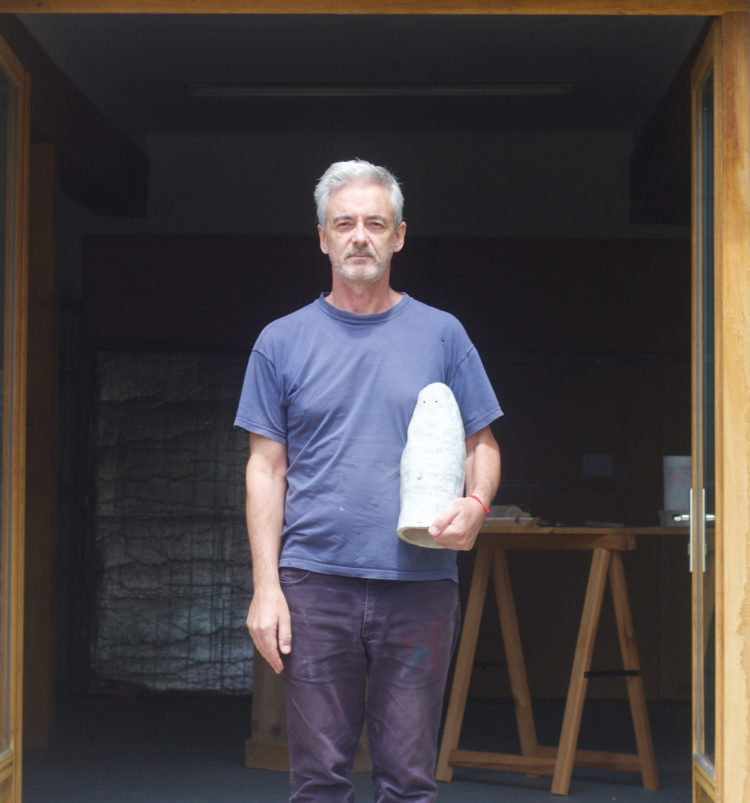
Any recognisable figures are boys – typically boisterous and physical – on the cusp of awkward adolescence. The painting ‘Saint Cybi and Saint Seiriol Together in Silent Prayer’ depict – presumably the 6th century Welsh saints – two boys in fake white beards, more scheming brothers than pious pilgrims.
We approach the work with our own cultural points of reference, looking for context and ‘hooks’ to understand. The burning house of ‘Croeso i Gymru’ is a comment on the actions of Meibion Glyndŵr and their destruction of holiday homes in Rielly’s own home county – is it not?
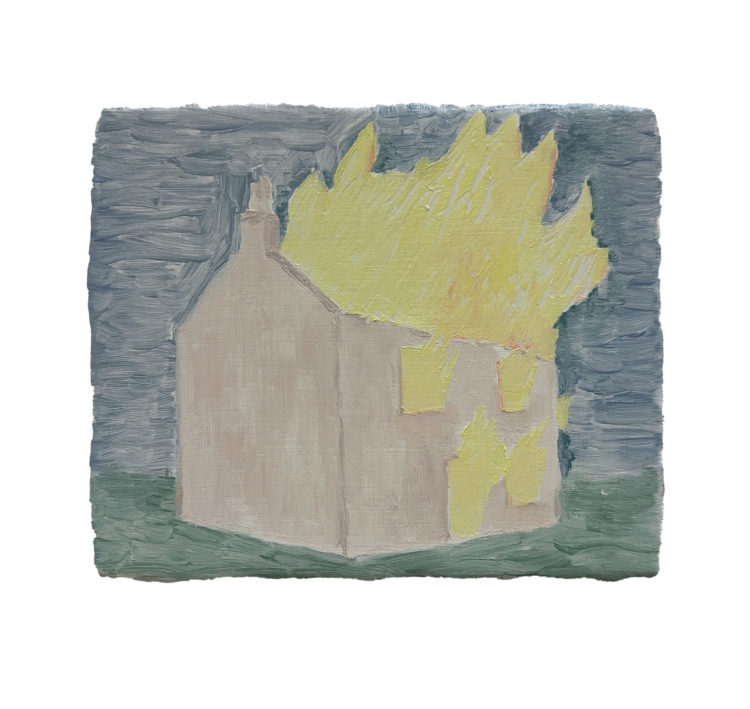
Humour is the prevalent note, and Rielly uses that gallows humour as a common tool to bring us in. The overarching theme here is that of us humans, our human condition and the world we have destroyed for ourselves.
Through pointing at the ridiculousness of it all and mock-laughing at the absurdity of modern life, Rielly’s sugar-coated satire gives us that buffer we need to look at ourselves without loosing hope – and to hopefully learn our lesson.
He offers us a coping mechanism – if we don’t laugh, we’ll cry.
Young British Artists
Rielly grew up in Holyhead, North Wales and now lives in France as a professor at Beaux-Arts de Paris. He was part of the London art scene of the 90s as one of the notable YBA’s – with his work included in Saatchi’s infamous ‘Sensation’ exhibition in 1997, alongside artists such as Tracy Emin, Damien Hirst and Chris Ofili.
The group of new paintings that James Rielly is showing at Gallery TEN are small works in oil on canvas. They are a group chosen from the studio for this exhibition. They are not, as has sometimes been the case, a single work made up of a number of smaller paintings.
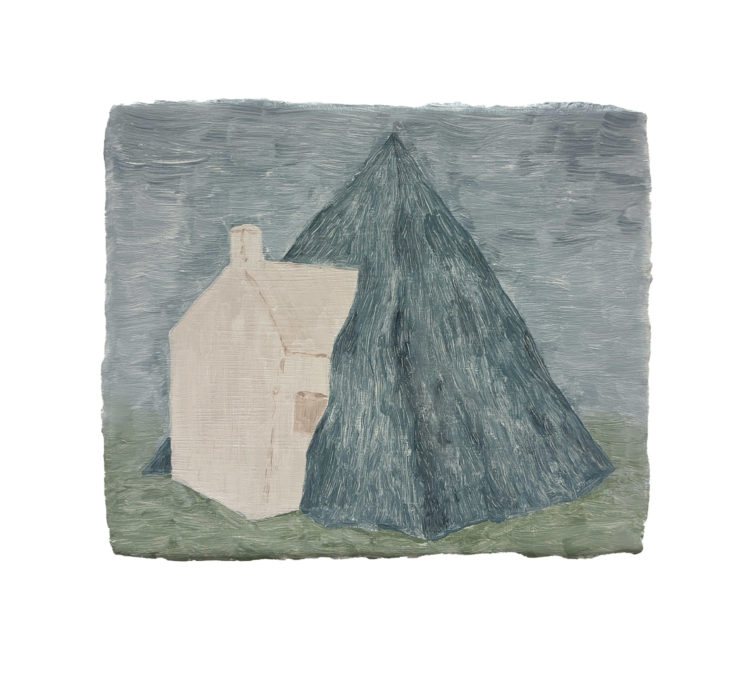
The title, ‘Tŷ Hyll’ refers to the exhibition as a whole. As many who know Eryri will recognise, it refers to the small cottage made of massive stone lumps, tucked into a plot under a steep mountainside and next to a busy road.
The artist explains that he passes Tŷ Hyll as he drives to and from his family home in North Wales. Tŷ Hyll is usually translated as ‘Ugly House’.
‘Tŷ Hyll’ is a title that Rielly has used before, for an exhibition in north Wales in 2014, curated by the artist Emrys Williams, and two subsequent exhibitions in France.
At first it directs our attention to three pieces in this exhibition which explicitly reference Wales ( it is the case that all his pictures depicting buildings only have Welsh titles).
Here, one is a quasi mythic invocation of storms and castles. Two are an image of a house, small, cosy, perhaps best described as a cottage, where a frightening drama has occurred. In ‘Croeso i Gymru’ flames released from inside are climbing above the roof.
In ‘Welsh Village 21 October 1966’ a pile of black engulfs the cottage, the title bearing the date of the disaster in Aberfan. This last painting returns to the motif of ‘Partially Buried’, one of the two major paintings by Rielly that are in the collection of Amgueddfa Cymru – National Museum Wales.
It speaks of the recurrence of this image in the artist’s mind. The two companion pieces in this exhibition make an intersection with it, by suggesting other ways that the security or attractiveness of the domestic can be shaken by forces from without.
Stories
Rielly enjoys the way Tŷ Hyll has many stories that attach to it: that it was built overnight so that the builders could claim its land; or that it was a base for highway robberies. ‘Hyll’ may in fact not even originally derive from describing the cottage.
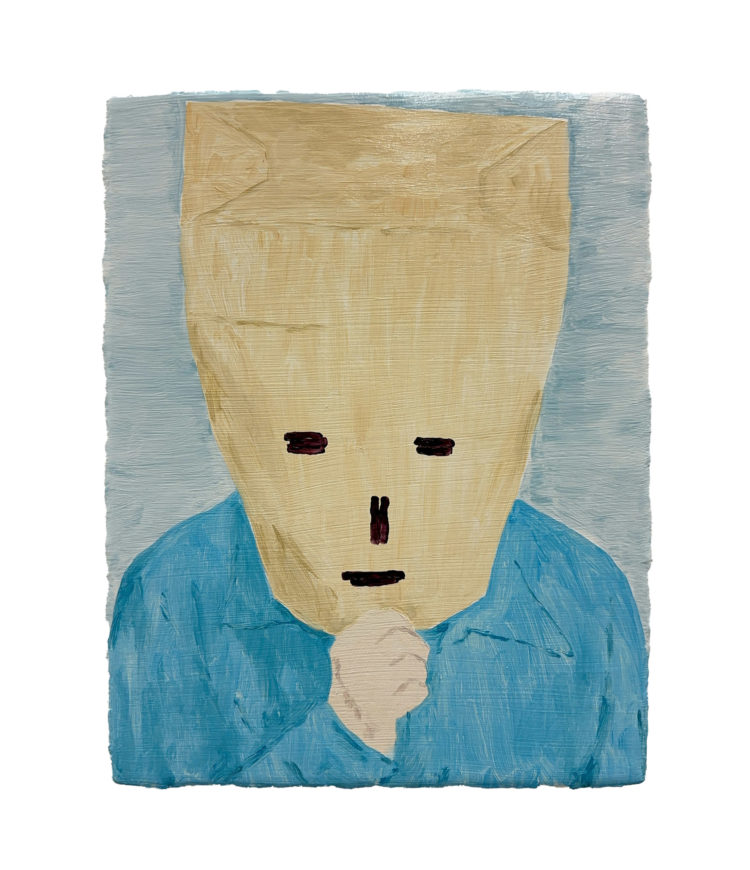
It might just be a corruption of the name of the river nearby. One might certainly enjoy the paradoxes involved in its celebration in Eryri’s ‘heritage’ landscape : as a website post says – “Join us at the lovely Tŷ Hyll”. That ambiguity – between the apparently safe and charming and the unsettling and disturbing, is also well known and widely seen as a distinguishing feature of his figurative paintings.
Rielly’s other work in Wales’ national Collections, ‘Pet’, is an example, a powerful image of a small girl with a black eye, holding a soft doll, also bearing a black eye. The present exhibition presents many examples of the figurative, all provoking nuanced versions of this central ambiguity.
Central to the achievement of ambiguity is the nature of the painting itself. We might find his paintings beautiful, full of light, with a wonderful sense of colour.
The handling and touch of the brush can be authoritative in the larger scale works, delicate in the smaller pieces. We have to manage this sense of the joy in painting when addressing the singularity of his imagery. This tension is often enhanced by the titles.

A head made up of bright stripes faces us : ‘Try to Blend In More’; a head covered (by a cloth?) with coloured spots : ‘Try to be More Desirable’. While working for the present exhibition and others in continental Europe, Rielly is also involved in a large monographic publication. This will bring together around 200 images of work from across his career.
Evolution
In discussing it, Rielly comments that it has again prompted the question of consistency and evolution in his work.
As well as cross referencing imagery or evolving new but consistent ways of painting, such questions as whether more recent work may (or may not) relate to early experiences and fascinations, or be the product of his education and first achievements in mature paintings, are called forth.
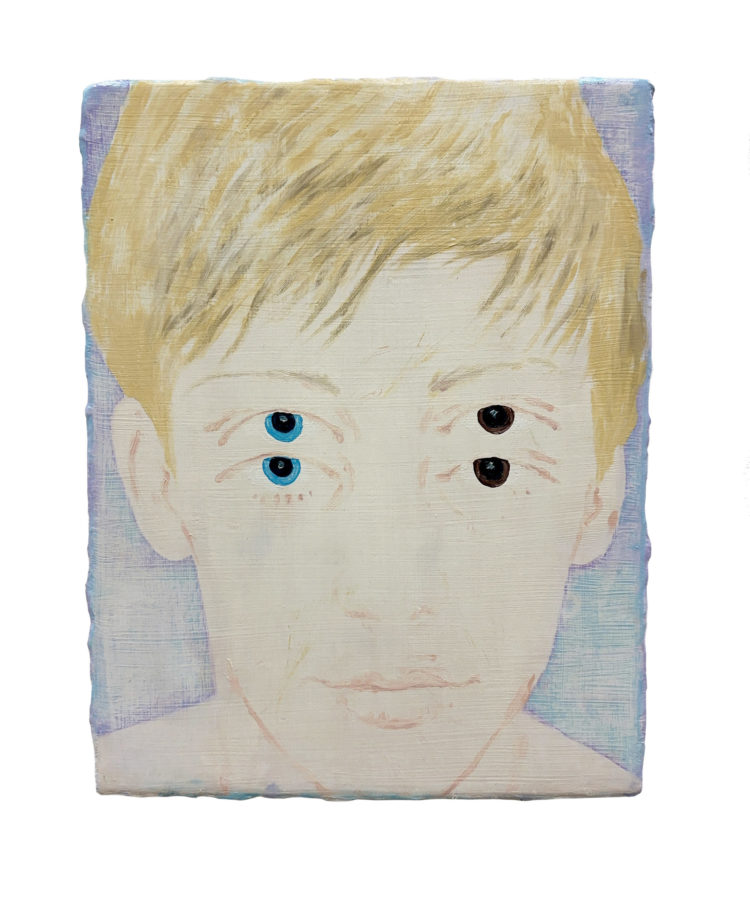
Rielly shared: “I have always collected images and made my paintings/drawings based on these images, found images cut up reworked and changed. This started at a young age.
“I did not know what I was doing. I always collected images together in scrap books, most of these have long disappeared . I had one with all the newspaper photos I could find about the death of Winston Churchill, this was the first half of a scrap book and the second half was Man from U.N.C.L.E. a tv program I loved.
“Also I had one just about the Aberfan disaster, as the children where about the same age as me. Others where about Dylan Thomas and so on.”
Welshness
The richness of his work – and its inter-weaving of motifs and images, media and scale – means that we are not allowed to reach a one-dimensional reading that can be attributed to a single origin story.
We might take two aspects of such a story to illustrate. James Rielly “is a Welsh artist living and working in France.” This simple summary from Wikipedia is often seen in references to his biography.
He explains that he grew up speaking Welsh as a small child until he had to speak English throughout his schooling. His Welsh was maintained through the Urdd Esiteddfod: he won prizes for singing, and for art.
His making art was encouraged by a teacher involved in the Urdd, giving confidence to the thought that this could be something he could pursue seriously.
What of his more formal early education? Leaving Wales to study at Cheltenham, Rielly then took an MA in art in Belfast, and returned shortly afterwards for a residency in the city. Obviously Belfast in the early 1980s was a complex, challenging environment, and one that provoked much creative energy.
Rielly was taught by Alastair MacLennan. MacLennan, with his quiet, thoughtful and gentle demeanour, made vivid durational performances and installations.
MacLennan also makes beautiful and uncanny drawings, which transfer the psychological and social power of his time-based work into monochromatic juxtapositions of objects and abstracted gestures.
In asking Rielly questions about moments in his career for this text, he had to break off from sawing and chopping logs in the home he loves, in preparation for an autumn and winter in rural France. Let us, then, take these narrative points of reference – a young person growing up in north Wales, a student and young artist in Belfast, an artist with a long career now living in France – not in a deterministic way, but more as intriguing examples of the many possibilities in which experience and imagination interact in how an artist works.
Rielly said: “When I started trying to be an artist, I felt I knew what I was doing and why I was doing it. Now I have no fixed idea and most of the time I cannot explain in an easy way what I am doing.”
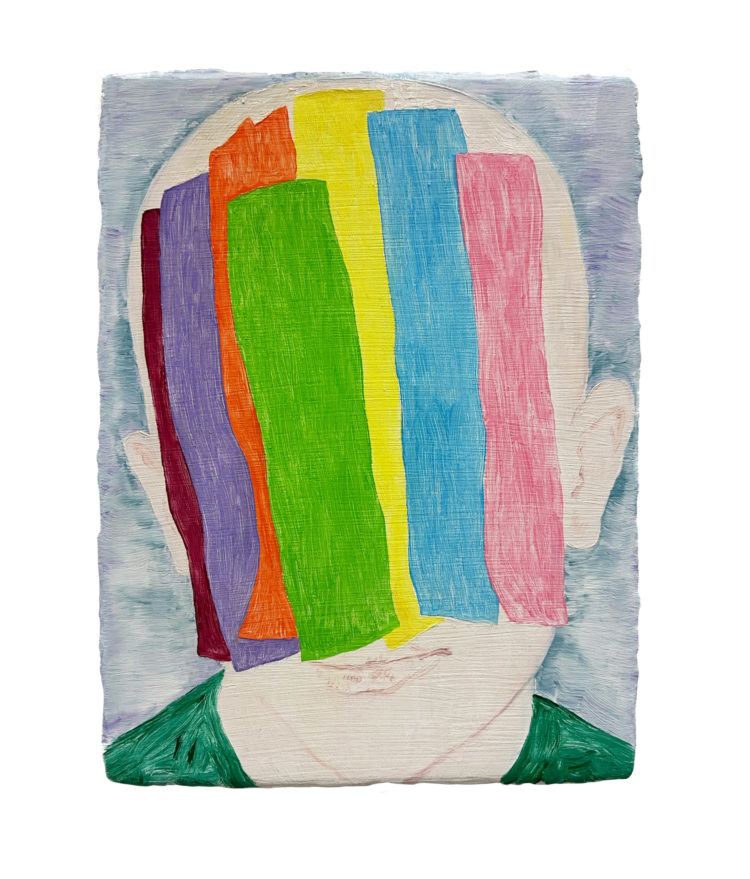
There is in this new group a work called ‘Blocking Out the Light’. The head seems to turn that one might find wistful, but one can’t be sure given that the eyes for once, do not meet ours.
Instead ribbons of colour overlay each other, the shallow space of the image allowing them to float on the surface of the painting.
One might say that the image is itself a metaphor for how it is created in the practice of painting.
Ty Hyll launches at Gallery Ten on Friday 25 October 2024 and runs until 30 November 2024
Open Wednesday – Saturday 10:30-17:00 at TEN. rear of 143 Donald Street Cardiff CF24 4TP
All artworks will be available to view and purchase online at www.gallery-ten.co.uk
Support our Nation today
For the price of a cup of coffee a month you can help us create an independent, not-for-profit, national news service for the people of Wales, by the people of Wales.




